Toronto is Canada’s largest city and it is a modern city, beautifully situated on the shores of Lake Ontario. There is something for everyone in Toronto, like metropolitan urban life, museums, historical sites and nature outings with a short drive to Niagara Falls as a popular day trip.
At the top of Toronto stands the 553 meter/1,815 feet high CN Tower, which is an impressive construction. The tour of the tower is a must for most visitors, and from its observation platforms there are unique views of the metropolis, the surrounding area and Lake Ontario.
Make a tour in Toronto’s history on several interesting places as well. At historic Fort York, the time is set back to the early 1800s, while the Royal Ontario Museum serves as a kind of national museum in the province with large collections in the fields of culture and nature. And enjoy the modern city center high-rise buildings as a part of the present day metropolitan experience.
If you want to go for a day trip from the city, the drive to Niagara Falls is a good choice. The US-Canada border is close to Toronto, and this is the place where the water constantly showers down the falls. The waterfall is easily accessible on a day trip with a lot of time to enjoy the tour from the Canadian metropolis.
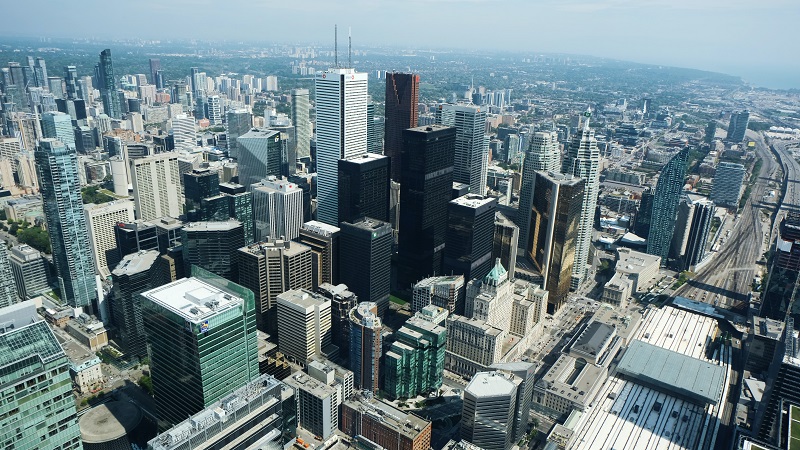
The CN Tower is a 553 meter high tower that stands as Toronto’s distinctive and distinctive landmark. CN stands for Canadian National, which was the railway company that built the tower on a former railway site. The tall tower was completed in 1976, and until the opening of the Burj Khalifa in Dubai, the CN Tower was the tallest building in the world. The tower held the record as the tallest tower until 2009, when the Canton Tower in Guangzhou surpassed it.
Canadian National started with plans for a communications tower and a symbol of the company and Canada’s industrial prowess in 1968. It was a time when Toronto was growing with many high-rises, and the CN Tower became taller than first intended. Fortunately, thought was given to viewing platforms in the tower, which you can visit and from which there are unforgettable views of the city and Lake Ontario. You can go to the main decks at a height of 340 meters or to the SkyPod 447 meters up.
Historic Fort York is one of Toronto’s significant historic buildings. The fort was originally built in 1793 as a garrison by British General John Graves Simcoe and was rebuilt 1813-1815. It was built to house British and Canadian military and to defend access to Toronto’s harbour. In 1870, Fort York was formally handed over to the Canadian military, and it was in sporadic military use until World War II.
Before then, in 1934, Fort York had been returned to the complex’s construction at the beginning of the 19th century, and it was opened as a museum for the military life of the century and especially for the depiction of the British-American war of 1812-1815, which ended with the British-Canadian victory as the Canadians managed to defend themselves and remain independent of the United States.
Today, the Fort York National Historic Site is located on approximately 16 hectares, where you can experience the fort itself and its surroundings. There is a visitor center in the fort’s buildings, where you can also see exhibitions with different themes, which, among other things, give an impression of the Battle of York in 1813, where the fort played a significant role in the future of Toronto.
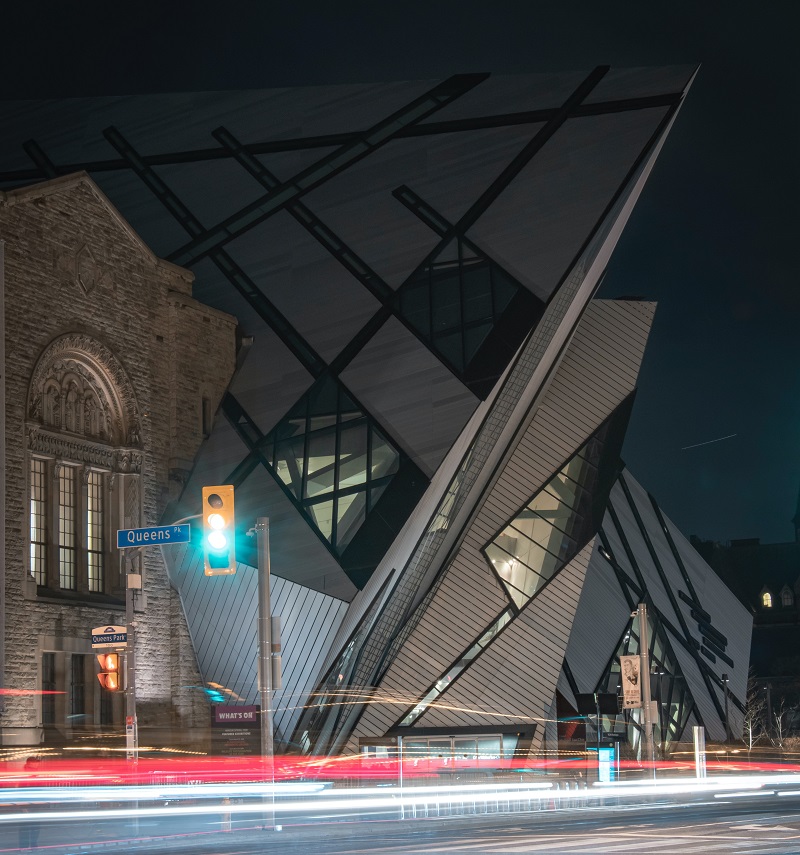
The Royal Ontario Museum in Toronto is Canada’s largest museum and definitely one of the country’s leading museums of international stature. The museum was founded in 1912 and depicts the world’s cultural and natural history. It opened in 1914 as a collaboration between the Ontario provincial government and the University of Toronto. The museum’s first collection came from the predecessor Museum of Natural History and Fine Arts.
Since its opening, the museum’s collections have grown considerably, and the museum building has been expanded several times to be able to offer more and more exciting exhibitions for the large audience that visits the Royal Ontario Museum each year. The original museum building was designed by the architectural firm of Frank Darling and John A. Pearson, and the beautifully ornamented structure today forms the west wing of the museum.
There were initially five major themed exhibitions at the museum. They spoke one for each of the fields of archaeology, geology, mineralogy, palaeontology and zoology. Today, the museum has been developed with lots of themes, interactivity and special exhibitions such as the well-known Royal Ontario Museum Bat Cave. There is also a lot of world culture in the collections, and you can explore virtually the entire world.
Cathedral Church of St. James is Toronto’s Anglican cathedral and is located in the city’s oldest parish, established in 1797. However, the current church was built later and became the episcopal seat in 1936 after the cathedral was moved from the diocese’s first cathedral, the Cathedral of St . Alban, which was never completed according to the original plans.
Cathedral Church of St. James was built from 1850 and the first service was held on June 19, 1853. The church was one of the largest buildings in Toronto at the time. Designed by Candian architect and engineer Frederick William Cumberland, the impressive church stands as an outstanding example of neo-Gothic architecture of the time.
The cathedral is 60 meters long and up to 30 meters wide, so it was a large building in relation to the size of the city in the mid-1800s. With the tower’s almost 93 meters in height, the spire is one of the tallest church towers in North America, and on the whole, the cathedral’s exterior is worth seeing with the architectural details, including the interplay between light brick and sandstone.
The church room is also worth a trip, and here you can see the cathedral’s large organ, which includes the original from 1853. The neo-Gothic style is also evident with pointed arches and other details, and you can also enjoy some beautiful decorations, including fine glass mosaics.
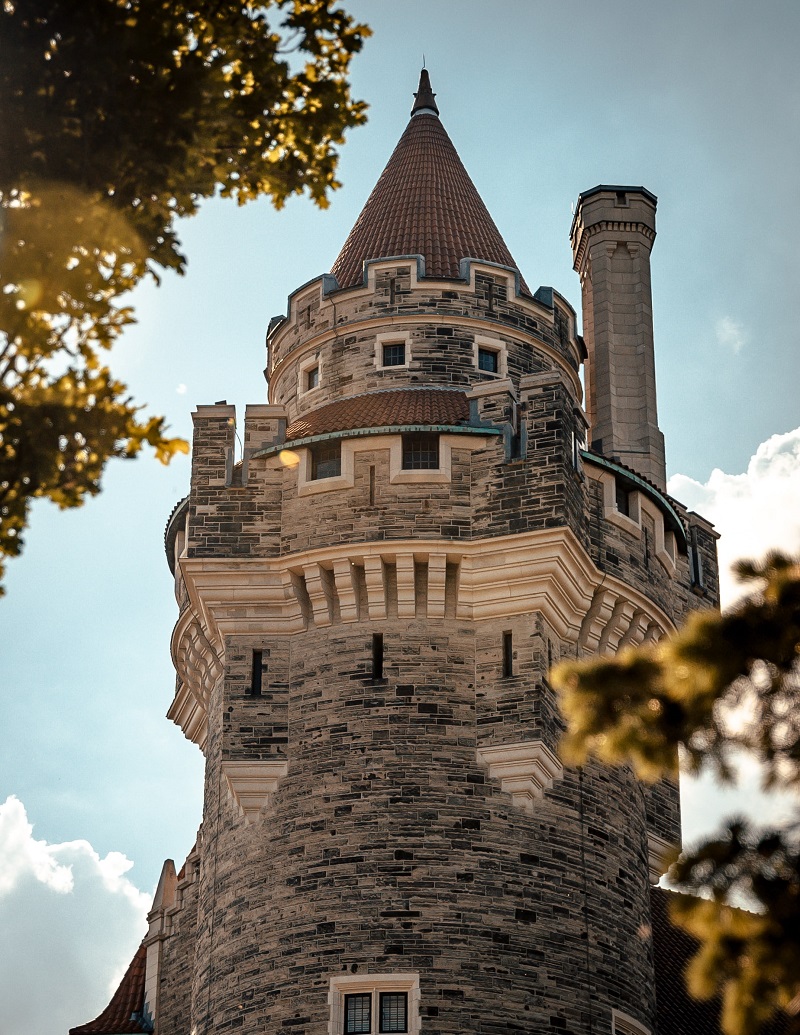
Casa Loma means House on the Hill, and it is one of Toronto’s well-known mansion buildings. As the name suggests, the castle-like mansion is magnificently situated with a lovely view of the city. It was the financier Sir Henry Mill Pellatt who had the architect Edward James Lennox build the mansion in the years 1911-1914 as his residence.
The architecture is Neo-Gothic, and it was built as a landscape with the main house and surrounding buildings such as a hunting lodge. The mansion itself had 98 rooms, making it the largest private residence in Canada. Due to financial challenges, Pallatt had to vacate Casa Loma in 1923.
Casa Loma was run as a luxury hotel for a short time, and in 1924 the city government confiscated the mansion due to unpaid taxes. In 1937, the house was opened as a tourist attraction, so the public could see the elegantly decorated halls of the house, which Pellatt had imported European craftsmen to create.
The Oak Room is the most beautifully decorated room in Casa Loma and was used for formal events. You can also see The Conservatory and Lady Pellatt’s Suite as other beautiful examples, and in the complex there is also a collection of old cars in the mansion’s associated stable building.
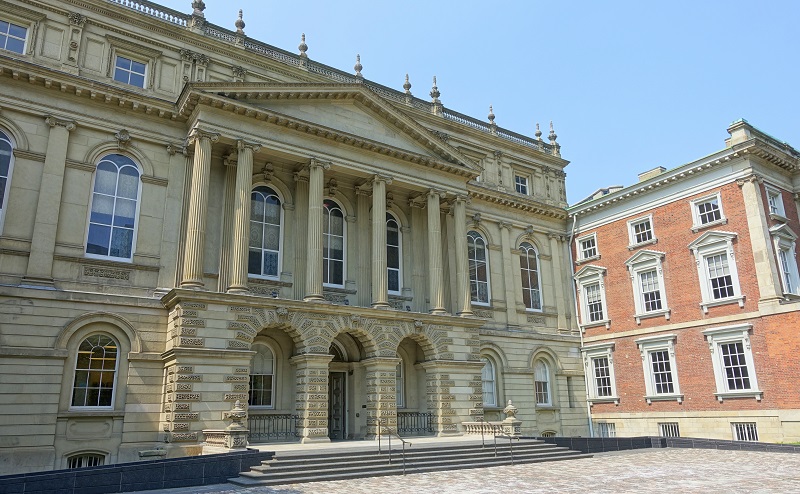
Osgoode Hall is one of Toronto’s largest buildings from the 19th century. The building was built in the years 1829-1832 by the legal authorities of the Province of Upper Canada. The name comes from Supreme Court Justice William Osgoode. It was John Ewart and William Warren Baldwin who designed the building, which was built in the late Palladian style.
The house originally served as a body for lawyers in Ontario along with a law school, it was formally established as Osgoode Hall Law School in 1889. Over the years the site was expanded and today Osgoode Hall is the seat of the Ontario Court of Appeal, Divisional Court of Superior Court of Justice, the offices of the Law Society of Ontario and the Great Library of the Law Society.
Osgoode Hall stands as a beautiful example of the late Palladian style with many neoclassical features. This can be seen, among other things, in the house’s Great Library and the large hall with beautiful floor mosaics and skylights. There are also other impressive furnishings, such as in the dining room and American Room.
The Harbourfront Center is a vibrant area with many activities located on a former warehouse site in Toronto’s waterfront district. The lively and cozy Harbourfront Center was developed to revitalize the site while using the old warehouses as a setting for various cultural and commercial purposes.
There are many opportunities for experience at the site, which annually hosts countless events in disciplines such as theatre, dance, literature, music, film, visual arts and crafts. Since the beginning, many well-known artists such as Celine Dion, Oscar Peterson, Julio Iglesias, Philip Glass and K.D. Long performed at the Harbourfront Centre.
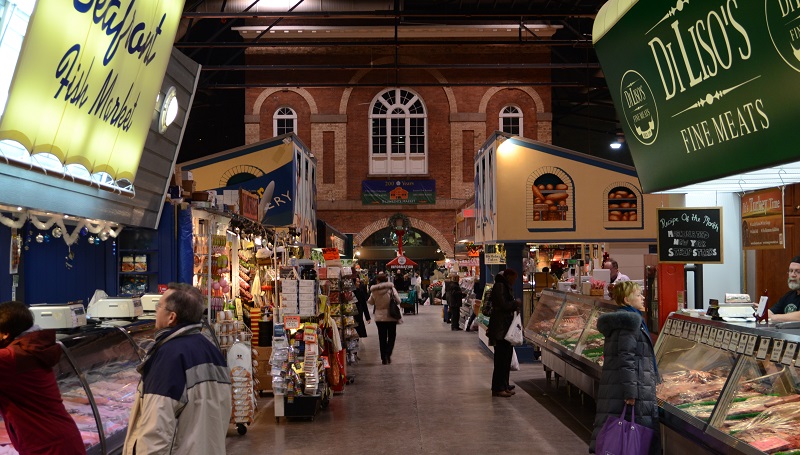
St. Lawrence Market is a market in Toronto whose history goes back to 1803, when Governor Peter Hunter laid out the area for trading purposes. The market was established with the first buildings in 1814, and since 1901 it has been known as one of the country’s best food markets.
There are several buildings in St. Lawrence Market. St. Lawrence Market South is the oldest and most atmospheric part of the market. The Market Hall was built in 1902, integrating the 1845 Toronto City Hall into the structure. St. Lawrence Market North, on the other hand, is a newer building that, however, also contains different parts of the market.
St. Michael’s Cathedral Basilica is Toronto’s Roman Catholic cathedral. It was designed by architect William Thomas, who also built several other churches in Toronto at the time. St. Michael’s Cathedral Basilica was built in neo-Gothic style 1845-1848, making it one of the city’s oldest churches.
When the church was opened, it was located some distance from the center of Toronto, but it is quite central today after the city’s colossal development since the mid-1800s. The church tower, at 79 meters in height, was also one of Toronto’s tallest structures for a long time.
St. Michael’s Cathedral Basilica stands in typical Neo-Gothic style, and this can clearly be seen on the cathedral’s beautiful exterior. Inside, you can experience a large and airy church room, where you can see, among other things, some beautiful stained glass windows such as Étienne Thévenot’s work from 1858. You may also be lucky enough to hear the famous St. Michael’s Choir, which is attached to the church.
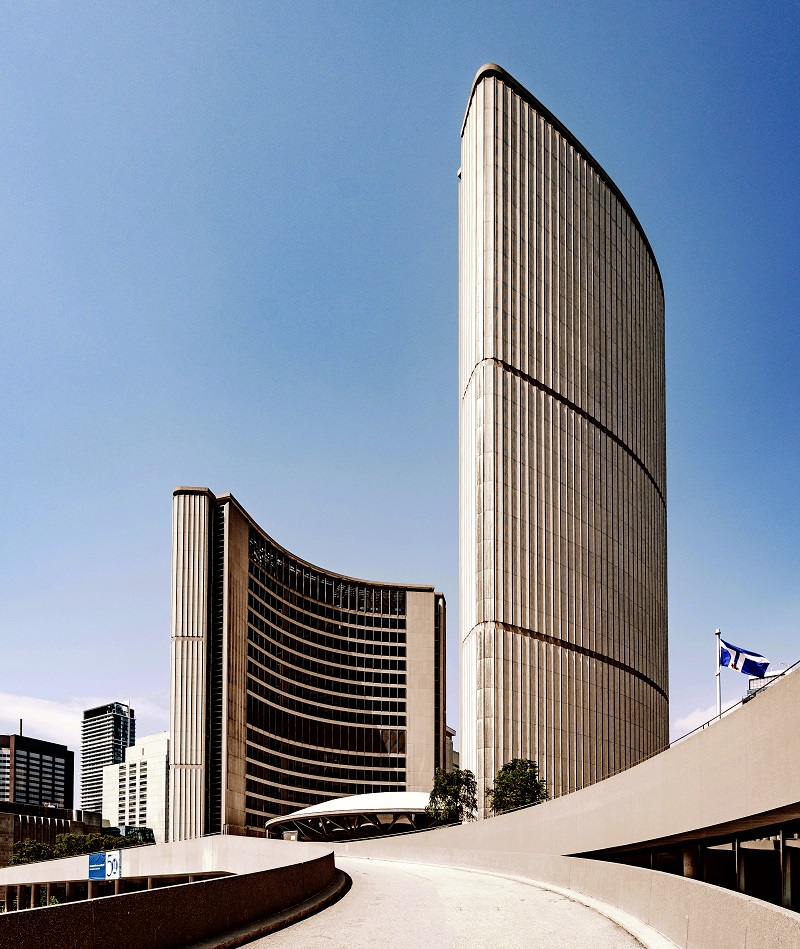
City Hall is Toronto’s city hall, and it stands as one of the city’s most distinctive modern buildings. The town hall replaced the nearby old town hall, which was used by the municipal government since 1899 and which continues to house municipal offices and agencies. The idea of a new town hall arose as early as the 1940s, but it took until 1961 before the City Hall construction was started.
The town hall opened in 1965, and the Finn Viljo Revell was the architect behind the modernist building. He designed the rectangular foundation with the two curved high-rise buildings, which the engineer Hannskarl Bandel realized. The high-rise buildings measure approximately 100 meters and 80 meters respectively in height, and between the towers there is a saucer-like building which houses the city council hall.
Old City Hall is Toronto’s former city hall, which was the seat of city government and Toronto’s administration from 1899 until the move to the current city hall in 1965. The building is particularly impressive with its grand neo-Romanesque architectural style, and the old city hall was one of the largest buildings in Toronto and the largest building of its kind in North America upon completion in 1899.
The City Hall building was designed by prominent Toronto architect Edward James Lennox, and construction lasted from 1889 to 1899. The building was constructed using stone from various locations in Canada, and they formed a harmonious whole in the exterior of the City Hall, which also features a 103 meter high bell tower. The large building opened, but despite the large volume, the town hall became too small after a few decades.
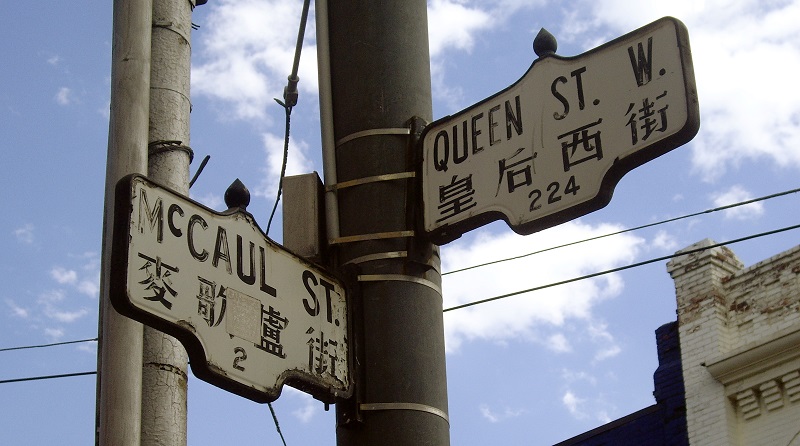
Chinatown is Toronto’s Chinese district. It is located between College Street, Queen Street, Spadina Avenue and University Avenue, centered around the intersection of Spadina Avenue and Dundas Street, West. The many Chinese in the area have left their mark on the neighborhood with shops, restaurants, etc., and this makes the neighborhood an experience.
Toronto’s first Chinatown was located in the area where the city’s current City Hall is located. It was renovated, and the Chinese established themselves in today’s Chinatown through the 1950s and 1960s. There were also new immigrants to the neighborhood, which grew as a result. Today, you can see many interesting details such as the street signs, which are also written in Chinese in Chinatown.
The Rogers Center is Toronto’s major arena from 1989, built as the SkyDome near the CN Tower on former railway land. Over the years, the arena has been home to many sports teams such as the Toronto Blue Jays and Toronto Argonauts.
The arena is primarily known as a sports venue, but it also hosts other large events such as conferences, fairs, concerts, circuses and monster truck shows. You can of course also keep an eye on upcoming sports matches in the large arena.
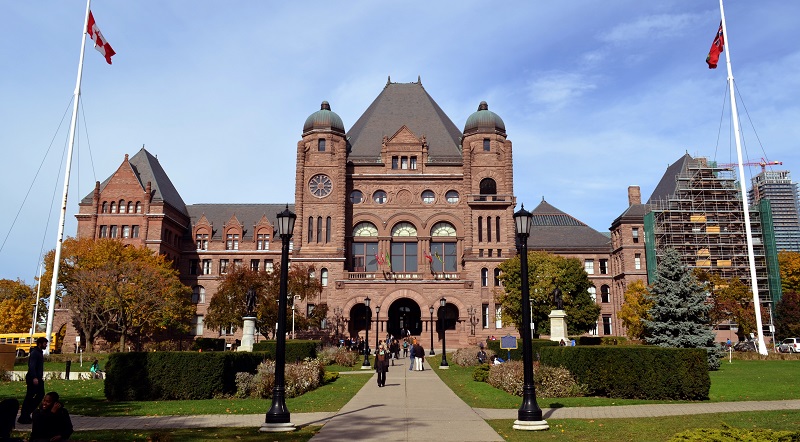
Ontario Legislative Buildings is the name of the Parliament building of the province of Ontario. It was built in the neo-Romanesque so-called Richardsonian Romanesque style in 1886-1892, which was widely used for contemporary public buildings. The architect behind the well-known building was the British-born American architect Richard Waite.
After a few years, the parliament building became too small and it was extended several times over the years. The north wing was built in 1909 by local architect George Wallace Gouinlock, and E.J. Lennox added two stories to the west wing. These extensions made the Ontario Legislative Buildings appear asymmetrical.
The varying appearance is repeated in the parliament’s beautifully decorated rooms and halls. Here you can see, among other things, differences in style in the walking halls in the eastern and western wings. The east wing was decorated in a Victorian style with dark wood panelling, while the west wing became Edwardian neoclassical with marble-clad light walls. Thereby they reflect the times in which they were built.
The Textile Museum of Canada is an interesting museum with a focus on textiles and clothing. At the museum, a cultural understanding of different peoples and their way of life is conveyed through more than 10,000 items of clothing and textiles from over 200 countries and regions.
The museum was founded as the Canadian Museum of Carpets and Textiles in 1975, and initially the collection was based on objects brought back from various travels. The collections and exhibitions grew considerably over the years to the fine museum you can see today.
The Royal York is the name of a large luxury hotel in Toronto that was built by the Canadian Pacific Railway from 1927 to 1929 as one of Canada’s famous railway hotels. The Royal York was built in a distinctive château style with a height of 124 metres, making the hotel Toronto’s tallest building when it opened.
When the hotel opened, there were 1,048 rooms and suites for rail travelers to use. With a location by Toronto’s Union Station, it was easy to get here, and during a stay you found yourself in fine surroundings with, for example, elegantly decorated halls such as the hotel’s ballroom and concert hall.
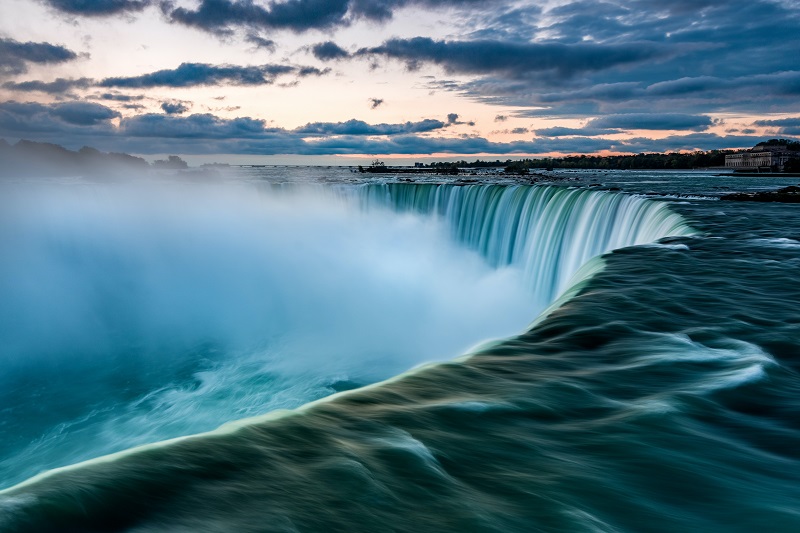
Niagara Falls is the name of some of the world’s most famous and visited waterfalls. The mighty falls are a wonder of nature and an experience for the senses that you will always remember. Every second, three million liters of water flow over the edge of the waterfall, which is located on the border between the United States and Canada.
There is a city on both sides of the border and thus the falls, both are called Niagara Falls, and the two cities are the centres of the large tourism to the area. There are lots of activities and hotels here, so you can get a lot more than the Niagara Falls experience from a trip here.
Niagara Falls is a group of three waterfalls located as the southern end of the Niagara Gorge, which the Niagara River has cut out of the underground over time. The largest of the waterfalls is the iconic Horseshoe Falls, located like a horseshoe with cascades of water on the very border between Canada and the United States.
In addition to Horseshoe Falls, Niagara Falls consists of American Falls and Bridal Veil Falls, both of which are smaller than Horsehoe Falls. Both of the smaller falls are on the American side of the border. Between Horseshoe Falls and Bridal Veil Falls is Goat Island, and between Bridal Veil Falls and American Falls is Luna Island.
You can see all three falls from the Canadian as well as the American side of the Niagara River. From Canada there is a panoramic view of the falls, and from here you get the best view of Horseshoe Falls and American Falls. From the US you can get very close to all the falls, and there is access to both Goat Island and Luna Island.
The Niagara River connects Lake Erie and Lake Ontario, and Niagara Falls is located en route between the lakes. The height of the fall is up to 57 meters, and Horseshoe Falls is the most watery in North America. The fall is 790 meters wide, while American Falls, as the second largest, is 320 meters wide.
Geologically, the Niagara River has cut through the subsurface all the way from Lake Ontario, and the waterfalls at Niagara Falls continue to erode about 30 centimeters of rock per year towards Lake Erie. When this process is complete, the falls have reached Lake Erie, at which point the waterfalls cease to exist.
St. Catharines is a city in the province of Ontario, located on the shores of Lake Ontario and close to Niagara Falls. It is a pearl of natural beauty and exciting man-made constructions, and St. Due to its location, Catharines is also a kind of center for Ontario’s wine production.
The town was founded by American Loyalists around 1780. The first settlers were two soldiers who settled where Dick’s Creek and Twelve Mile Creek meet. The first shop was opened in 1783, and three years later the first mill opened. The area was then measured and divided, and development continued.
The name St. Catharines first appeared on a map in 1808. The town was named after Robert Hamilton’s wife, who had opened the town’s first store, Catharine Hamilton. From 1821, the town was officially called St. Catharines since 1821, and with the construction of the Welland Canal from 1824 to 1833, the city became the economic and industrial center of the area.
There are many attractions in St. Catharines, and many of them are located in the city’s downtown, which in itself exudes a good atmosphere. You can, for example, take a walk along St Paul Street or go to the city’s famous Farmer’s Market at Market Square, whose history dates back to the 1860s. Here you can buy local food and enjoy cafes and restaurants.
You can also take a trip to Port Dalhousie, which is one of the city’s northern neighborhoods along Lake Ontario. Port Dalhousie offers cozy streets, beaches and a maritime environment. You can also go to the Welland Canal east of St. Catharines and, for example, visit St. Catharines Museum and Welland Canals Centre, which tells in an exciting way about the great engineering work that the canal is.
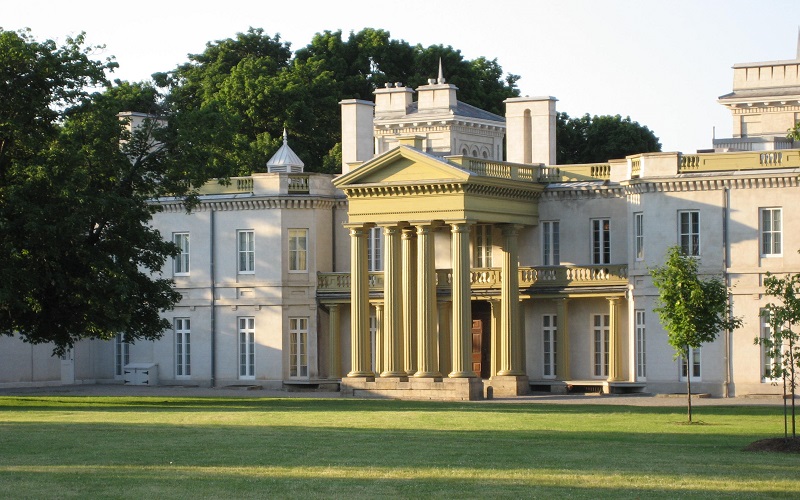
Hamilton is one of the largest cities in the Canadian province of Ontario. The area was first visited by Europeans in the 17th century, but it was only after the American War of Independence when settlers arrived in larger numbers. In 1792, the British Crown acquired the land where Hamilton is today from local tribes.
The British-loyal settlers from the United States were encouraged to settle the purchased land. Later, George Hamilton bought tracts of land which he offered to the government to establish a future city, which became Hamilton. In 1816 the city was chosen as the regional administrative center, and from 1832 there was considerable growth when a canal was dug to Hamilton, which could thereby become a port city.
Brantford is a city in the province of Ontario. It was founded along the Grand River on a piece of land given to Captain Joseph Brant in 1784 for his loyalty to the British Crown. The land was good and became Brant’s Crossing, which grew as a settlement in the early 1800s.
Today, there are several interesting sights in Brantford, known as the home of Alexander Graham Bell. You can see the Bell Homestead National Historic Site, where Alexander Graham Bell made the first telephone call, and the Bell Memorial, designed by Walter Seymour Allward to commemorate the invention of the telephone.
There are several museums and cultural sites in Brantford such as the Woodland Cultural Centre, the Brant Museum and Archives, the Canadian Military Heritage Museum and the Personal Computer Museum.
220 Yonge Street
torontoeatoncentre.com
1800 Sheppard Avenue
fariviewmall.ca
100 King Street W
firstcanadianplace.com
500 Rexdale Boulevard
woodbinecentre.ca
20 Eglinton Avenue W
yongeeglintoncentre.com
3401 Dufferin Street
yorkdale.com
Bay Street, Bloor Street W, Queen Street W, Path System (downtown pedestrian malls), Yonge Street
Toronto Zoo
Meadowvale Road, Scarborough
torontozoo.com
Toronto Island Park
torontoisland.com
Hockey Hall of Fame
30 Yonge Street
hhof.com
Paramount Canada’s Wonderland
canadaswonderland.com
Centerville Island Park
centreisland.ca
The Toronto region has been inhabited for millennia. As the ice age’s ice cap receded, settlers from the south came. The settlers were alone in the area for a long time.
The first Europeans arrived in the 1600s, but many years went from the first visit to actual European settlements. France, which sought to expand its colony of New France in present-day Québec, set up trading stations in the early 18th century, but it was Montréal who was the real city of the French.
After the English conquest and annexation of the French territories in Canada, a Toronto development began. In 1787, England purchased the entire area of the Native American Mississaugas tribe and thus a colonization could take off.
It was a time of imminent opportunity for American invasion of English Canada. The United States was established and rapidly expanded its territories in a western direction. As part of the English defense, John Graves Simcoe established a military outpost in 1793 and at the same time founded a civilian city, which he called York. In the English province of Upper Canada, the smaller city of Niagara had been the capital, but the dangerous proximity to the United States meant that Simcoe granted York this status.
York remained a small village for many years, exposed to several American attacks. A development had not started and thus only 720 people lived in the city in 1814.
From 1815, the role of the city in Canada, and thus the general development, came as well. York became the capital of the colony, thereby establishing many common national institutions in the city. Others chose York as the city of establishment due to the density of the political center. This included, for example, banks and major educational establishments. Finally, York was also geographically well-positioned in relation to the Anglo-Canadian colonization to the west in the great Canadian hinterland.
In 1834, when York was merged with the Toronto neighborhood, nearly 10,000 people lived in York, which had been expanded in its area to accommodate the many new arrivals arriving each year. Around 1850, the population numbered about 30,000, and the city was Upper Canada’s largest.
The decades in the mid-1800s had offered many attacks against the city, but the city’s growth continued unabated. Cholera epidemics had erupted in 1832, 1834 and 1849, while an uprising had almost divided the city in the period 1837-1838. In 1847-1848 typhus hit the city, and in 1849 a major fire ravaged.
By 1853, the city’s first railway line was opened, and the modern city had been both sewered and had gas lighting and water lines installed. Significant buildings such as St. James’ Cathedral and St. Lawrence Hall was also erected during this period of growth. The city was developed according to modern principles with division into commercial areas and residential districts. During the period, the city also underwent greater industrialization.
After many decades of growth, the population numbered 200,000 in 1900, and through the first half of that century quadrupled, and Toronto began to become a competitor of Montreal in size and economics. Culturally, too, a development took place in the city, where The Royal Ontario Museum opened in 1912 and the Symphony in 1922.
During the two world wars, many of the city’s inhabitants participated on the English side. Of the city’s citizens, 78% were of English origin and were therefore more participatory than from other parts of Canada. After the end of World War II, many soldiers returned, and at the same time the first major wave of immigration began, causing the population to increase explosively over the following years.
The relatively small Toronto, with the waves of immigration, expanded in its area and created the breeding ground for many of the large facilities seen in both downtown and in the many newly constructed suburbs.
Toronto became Canada’s largest city in 1976, and today it is Canada’s financial center, where countless modern buildings, shopping malls and cultural institutions are an integral part of the experience. The city is considered to be one of the world’s most multicultural. Here, more than 150 languages and dialects are spoken, and the different peoples live in harmony with each other.
In 1998, the city was merged with surrounding municipalities, bringing the number of citizens to 2.6 million, including the suburbs living here at nearly 5 million people, making the Toronto area one of North America’s major metropolises. The city is still growing and the last 100 years of significant population growth is expected to be sustained in the coming decades.

Overview of Toronto
Toronto is Canada’s largest city and it is a modern city, beautifully situated on the shores of Lake Ontario. There is something for everyone in the city, like metropolitan urban life, museums, historical sites and nature outings with a short drive to Niagara Falls as a popular day trip.
At the top of town stands the 553 meter/1,815 feet high CN Tower, which is an impressive construction. The tour of the tower is a must for most visitors, and from its observation platforms there are unique views of the metropolis, the surrounding area and Lake Ontario.
About the upcoming Toronto travel guide
About the travel guide
The Toronto travel guide gives you an overview of the sights and activities of the Canadian city. Read about top sights and other sights, and get a tour guide with tour suggestions and detailed descriptions of all the city’s most important churches, monuments, mansions, museums, etc.
Toronto is waiting for you, and at vamados.com you can also find cheap flights and great deals on hotels for your trip. You just select your travel dates and then you get flight and accommodation suggestions in and around the city.
Read more about Toronto and Canada
Buy the travel guide
Click the “Add to Cart” button to purchase the travel guide. After that you will come to the payment, where you enter the purchase and payment information. Upon payment of the travel guide, you will immediately receive a receipt with a link to download your purchase. You can download the travel guide immediately or use the download link in the email later.
Use the travel guide
When you buy the travel guide to Toronto you get the book online so you can have it on your phone, tablet or computer – and of course you can choose to print it. Use the maps and tour suggestions and you will have a good and content-rich journey.
CN Tower • Museums • Lake Ontario • Niagara Falls

Overview of Toronto
Toronto is Canada’s largest city and it is a modern city, beautifully situated on the shores of Lake Ontario. There is something for everyone in the city, like metropolitan urban life, museums, historical sites and nature outings with a short drive to Niagara Falls as a popular day trip.
At the top of town stands the 553 meter/1,815 feet high CN Tower, which is an impressive construction. The tour of the tower is a must for most visitors, and from its observation platforms there are unique views of the metropolis, the surrounding area and Lake Ontario.
About the upcoming Toronto travel guide
About the travel guide
The Toronto travel guide gives you an overview of the sights and activities of the Canadian city. Read about top sights and other sights, and get a tour guide with tour suggestions and detailed descriptions of all the city’s most important churches, monuments, mansions, museums, etc.
Toronto is waiting for you, and at vamados.com you can also find cheap flights and great deals on hotels for your trip. You just select your travel dates and then you get flight and accommodation suggestions in and around the city.
Read more about Toronto and Canada
Buy the travel guide
Click the “Add to Cart” button to purchase the travel guide. After that you will come to the payment, where you enter the purchase and payment information. Upon payment of the travel guide, you will immediately receive a receipt with a link to download your purchase. You can download the travel guide immediately or use the download link in the email later.
Use the travel guide
When you buy the travel guide to Toronto you get the book online so you can have it on your phone, tablet or computer – and of course you can choose to print it. Use the maps and tour suggestions and you will have a good and content-rich journey.

Osgoode Hall is one of Toronto’s largest buildings from the 19th century. The building was built in the years 1829-1832 by the legal authorities of the Province of Upper Canada. The name comes from Supreme Court Justice William Osgoode. It was John Ewart and William Warren Baldwin who designed the building, which was built in the late Palladian style.
The house originally served as a body for lawyers in Ontario along with a law school, it was formally established as Osgoode Hall Law School in 1889. Over the years the site was expanded and today Osgoode Hall is the seat of the Ontario Court of Appeal, Divisional Court of Superior Court of Justice, the offices of the Law Society of Ontario and the Great Library of the Law Society.
Osgoode Hall stands as a beautiful example of the late Palladian style with many neoclassical features. This can be seen, among other things, in the house’s Great Library and the large hall with beautiful floor mosaics and skylights. There are also other impressive furnishings, such as in the dining room and American Room.
The Harbourfront Center is a vibrant area with many activities located on a former warehouse site in Toronto’s waterfront district. The lively and cozy Harbourfront Center was developed to revitalize the site while using the old warehouses as a setting for various cultural and commercial purposes.
There are many opportunities for experience at the site, which annually hosts countless events in disciplines such as theatre, dance, literature, music, film, visual arts and crafts. Since the beginning, many well-known artists such as Celine Dion, Oscar Peterson, Julio Iglesias, Philip Glass and K.D. Long performed at the Harbourfront Centre.

St. Lawrence Market is a market in Toronto whose history goes back to 1803, when Governor Peter Hunter laid out the area for trading purposes. The market was established with the first buildings in 1814, and since 1901 it has been known as one of the country’s best food markets.
There are several buildings in St. Lawrence Market. St. Lawrence Market South is the oldest and most atmospheric part of the market. The Market Hall was built in 1902, integrating the 1845 Toronto City Hall into the structure. St. Lawrence Market North, on the other hand, is a newer building that, however, also contains different parts of the market.
St. Michael’s Cathedral Basilica is Toronto’s Roman Catholic cathedral. It was designed by architect William Thomas, who also built several other churches in Toronto at the time. St. Michael’s Cathedral Basilica was built in neo-Gothic style 1845-1848, making it one of the city’s oldest churches.
When the church was opened, it was located some distance from the center of Toronto, but it is quite central today after the city’s colossal development since the mid-1800s. The church tower, at 79 meters in height, was also one of Toronto’s tallest structures for a long time.
St. Michael’s Cathedral Basilica stands in typical Neo-Gothic style, and this can clearly be seen on the cathedral’s beautiful exterior. Inside, you can experience a large and airy church room, where you can see, among other things, some beautiful stained glass windows such as Étienne Thévenot’s work from 1858. You may also be lucky enough to hear the famous St. Michael’s Choir, which is attached to the church.

City Hall is Toronto’s city hall, and it stands as one of the city’s most distinctive modern buildings. The town hall replaced the nearby old town hall, which was used by the municipal government since 1899 and which continues to house municipal offices and agencies. The idea of a new town hall arose as early as the 1940s, but it took until 1961 before the City Hall construction was started.
The town hall opened in 1965, and the Finn Viljo Revell was the architect behind the modernist building. He designed the rectangular foundation with the two curved high-rise buildings, which the engineer Hannskarl Bandel realized. The high-rise buildings measure approximately 100 meters and 80 meters respectively in height, and between the towers there is a saucer-like building which houses the city council hall.
Old City Hall is Toronto’s former city hall, which was the seat of city government and Toronto’s administration from 1899 until the move to the current city hall in 1965. The building is particularly impressive with its grand neo-Romanesque architectural style, and the old city hall was one of the largest buildings in Toronto and the largest building of its kind in North America upon completion in 1899.
The City Hall building was designed by prominent Toronto architect Edward James Lennox, and construction lasted from 1889 to 1899. The building was constructed using stone from various locations in Canada, and they formed a harmonious whole in the exterior of the City Hall, which also features a 103 meter high bell tower. The large building opened, but despite the large volume, the town hall became too small after a few decades.

Chinatown is Toronto’s Chinese district. It is located between College Street, Queen Street, Spadina Avenue and University Avenue, centered around the intersection of Spadina Avenue and Dundas Street, West. The many Chinese in the area have left their mark on the neighborhood with shops, restaurants, etc., and this makes the neighborhood an experience.
Toronto’s first Chinatown was located in the area where the city’s current City Hall is located. It was renovated, and the Chinese established themselves in today’s Chinatown through the 1950s and 1960s. There were also new immigrants to the neighborhood, which grew as a result. Today, you can see many interesting details such as the street signs, which are also written in Chinese in Chinatown.
The Rogers Center is Toronto’s major arena from 1989, built as the SkyDome near the CN Tower on former railway land. Over the years, the arena has been home to many sports teams such as the Toronto Blue Jays and Toronto Argonauts.
The arena is primarily known as a sports venue, but it also hosts other large events such as conferences, fairs, concerts, circuses and monster truck shows. You can of course also keep an eye on upcoming sports matches in the large arena.

Ontario Legislative Buildings is the name of the Parliament building of the province of Ontario. It was built in the neo-Romanesque so-called Richardsonian Romanesque style in 1886-1892, which was widely used for contemporary public buildings. The architect behind the well-known building was the British-born American architect Richard Waite.
After a few years, the parliament building became too small and it was extended several times over the years. The north wing was built in 1909 by local architect George Wallace Gouinlock, and E.J. Lennox added two stories to the west wing. These extensions made the Ontario Legislative Buildings appear asymmetrical.
The varying appearance is repeated in the parliament’s beautifully decorated rooms and halls. Here you can see, among other things, differences in style in the walking halls in the eastern and western wings. The east wing was decorated in a Victorian style with dark wood panelling, while the west wing became Edwardian neoclassical with marble-clad light walls. Thereby they reflect the times in which they were built.
The Textile Museum of Canada is an interesting museum with a focus on textiles and clothing. At the museum, a cultural understanding of different peoples and their way of life is conveyed through more than 10,000 items of clothing and textiles from over 200 countries and regions.
The museum was founded as the Canadian Museum of Carpets and Textiles in 1975, and initially the collection was based on objects brought back from various travels. The collections and exhibitions grew considerably over the years to the fine museum you can see today.
The Royal York is the name of a large luxury hotel in Toronto that was built by the Canadian Pacific Railway from 1927 to 1929 as one of Canada’s famous railway hotels. The Royal York was built in a distinctive château style with a height of 124 metres, making the hotel Toronto’s tallest building when it opened.
When the hotel opened, there were 1,048 rooms and suites for rail travelers to use. With a location by Toronto’s Union Station, it was easy to get here, and during a stay you found yourself in fine surroundings with, for example, elegantly decorated halls such as the hotel’s ballroom and concert hall.
Similar to Toronto Travel Guide